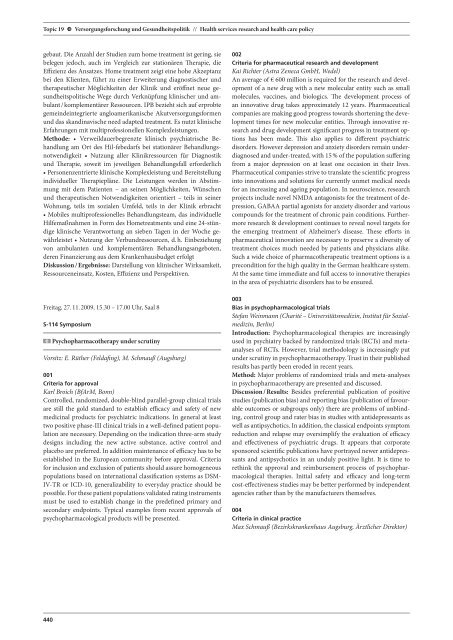Psychische Erkrankungen in der Lebensspanne ... - DGPPN
Psychische Erkrankungen in der Lebensspanne ... - DGPPN
Psychische Erkrankungen in der Lebensspanne ... - DGPPN
Sie wollen auch ein ePaper? Erhöhen Sie die Reichweite Ihrer Titel.
YUMPU macht aus Druck-PDFs automatisch weboptimierte ePaper, die Google liebt.
Topic 19 G Versorgungsforschung und Gesundheitspolitik // Health services research and health care policy<br />
gebaut. Die Anzahl <strong>der</strong> Studien zum home treatment ist ger<strong>in</strong>g, sie<br />
belegen jedoch, auch im Vergleich zur stationären Therapie, die<br />
Effizienz des Ansatzes. Home treatment zeigt e<strong>in</strong>e hohe Akzeptanz<br />
bei den Klienten, führt zu e<strong>in</strong>er Erweiterung diagnostischer und<br />
therapeutischer Möglichkeiten <strong>der</strong> Kl<strong>in</strong>ik und eröffnet neue gesundheitspolitische<br />
Wege durch Verknüpfung kl<strong>in</strong>ischer und ambulant<br />
/ komplementärer Ressourcen. IPB bezieht sich auf erprobte<br />
geme<strong>in</strong>de<strong>in</strong>tegrierte angloamerikanische Akutversorgungsformen<br />
und das skand<strong>in</strong>avische need adapted treatment. Es nutzt kl<strong>in</strong>ische<br />
Erfahrungen mit multiprofessionellen Komplexleistungen.<br />
Methode: • Verweildauerbegrenzte kl<strong>in</strong>isch psychiatrische Behandlung<br />
am Ort des Hil-febedarfs bei stationärer Behandlungsnotwendigkeit<br />
• Nutzung aller Kl<strong>in</strong>ikressourcen für Diagnostik<br />
und Therapie, soweit im jeweiligen Behandlungsfall erfor<strong>der</strong>lich<br />
• Personenzentrierte kl<strong>in</strong>ische Komplexleistung und Bereitstellung<br />
<strong>in</strong>dividueller Therapiepläne. Die Leistungen werden <strong>in</strong> Abstimmung<br />
mit dem Patienten – an se<strong>in</strong>en Möglichkeiten, Wünschen<br />
und therapeutischen Notwendigkeiten orientiert – teils <strong>in</strong> se<strong>in</strong>er<br />
Wohnung, teils im sozialen Umfeld, teils <strong>in</strong> <strong>der</strong> Kl<strong>in</strong>ik erbracht<br />
• Mobiles multiprofessionelles Behandlungsteam, das <strong>in</strong>dividuelle<br />
Hilfemaßnahmen <strong>in</strong> Form des Hometreatments und e<strong>in</strong>e 24-stündige<br />
kl<strong>in</strong>ische Verantwortung an sieben Tagen <strong>in</strong> <strong>der</strong> Woche gewährleistet<br />
• Nutzung <strong>der</strong> Verbundressourcen, d.h. E<strong>in</strong>beziehung<br />
von ambulanten und komplementären Behandlungsangeboten,<br />
<strong>der</strong>en F<strong>in</strong>anzierung aus dem Krankenhausbudget erfolgt<br />
Diskussion / Ergebnisse: Darstellung von kl<strong>in</strong>ischer Wirksamkeit,<br />
Ressourcene<strong>in</strong>satz, Kosten, Effizienz und Perspektiven.<br />
Freitag, 27. 11. 2009, 15.30 – 17.00 Uhr, Saal 8<br />
S-114 Symposium<br />
440<br />
Psychopharmacotherapy un<strong>der</strong> scrut<strong>in</strong>y<br />
Vorsitz: E. Rüther (Feldaf<strong>in</strong>g), M. Schmauß (Augsburg)<br />
001<br />
Criteria for approval<br />
Karl Broich (BfArM, Bonn)<br />
Controlled, randomized, double-bl<strong>in</strong>d parallel-group cl<strong>in</strong>ical trials<br />
are still the gold standard to establish efficacy and safety of new<br />
medic<strong>in</strong>al products for psychiatric <strong>in</strong>dications. In general at least<br />
two positive phase-III cl<strong>in</strong>ical trials <strong>in</strong> a well-def<strong>in</strong>ed patient population<br />
are necessary. Depend<strong>in</strong>g on the <strong>in</strong>dication three-arm study<br />
designs <strong>in</strong>clud<strong>in</strong>g the new active substance, active control and<br />
placebo are preferred. In addition ma<strong>in</strong>tenance of efficacy has to be<br />
established <strong>in</strong> the European community before approval. Criteria<br />
for <strong>in</strong>clusion and exclusion of patients should assure homogeneous<br />
populations based on <strong>in</strong>ternational classification systems as DSM-<br />
IV-TR or ICD-10, generalizability to everyday practice should be<br />
possible. For these patient populations validated rat<strong>in</strong>g <strong>in</strong>struments<br />
must be used to establish change <strong>in</strong> the predef<strong>in</strong>ed primary and<br />
secondary endpo<strong>in</strong>ts. Typical examples from recent approvals of<br />
psychopharmacological products will be presented.<br />
002<br />
Criteria for pharmaceutical research and development<br />
Kai Richter (Astra Zeneca GmbH, Wedel)<br />
An average of € 600 million is required for the research and development<br />
of a new drug with a new molecular entity such as small<br />
molecules, vacc<strong>in</strong>es, and biologics. The development process of<br />
an <strong>in</strong>novative drug takes approximately 12 years. Pharmaceutical<br />
companies are mak<strong>in</strong>g good progress towards shorten<strong>in</strong>g the development<br />
times for new molecular entities. Through <strong>in</strong>novative research<br />
and drug development significant progress <strong>in</strong> treatment options<br />
has been made. This also applies to different psychiatric<br />
disor<strong>der</strong>s. However depression and anxiety disor<strong>der</strong>s rema<strong>in</strong> un<strong>der</strong>-<br />
diagnosed and un<strong>der</strong>-treated, with 15 % of the population suffer<strong>in</strong>g<br />
from a major depression on at least one occasion <strong>in</strong> their lives.<br />
Pharmaceutical companies strive to translate the scientific progress<br />
<strong>in</strong>to <strong>in</strong>novations and solutions for currently unmet medical needs<br />
for an <strong>in</strong>creas<strong>in</strong>g and age<strong>in</strong>g population. In neuroscience, research<br />
projects <strong>in</strong>clude novel NMDA antagonists for the treatment of depression,<br />
GABAA partial agonists for anxiety disor<strong>der</strong> and various<br />
compounds for the treatment of chronic pa<strong>in</strong> conditions. Furthermore<br />
research & development cont<strong>in</strong>ues to reveal novel targets for<br />
the emerg<strong>in</strong>g treatment of Alzheimer‘s disease. These efforts <strong>in</strong><br />
pharmaceutical <strong>in</strong>novation are necessary to preserve a diversity of<br />
treatment choices much needed by patients and physicians alike.<br />
Such a wide choice of pharmacotherapeutic treatment options is a<br />
precondition for the high quality <strong>in</strong> the German healthcare system.<br />
At the same time immediate and full access to <strong>in</strong>novative therapies<br />
<strong>in</strong> the area of psychiatric disor<strong>der</strong>s has to be ensured.<br />
003<br />
Bias <strong>in</strong> psychopharmacological trials<br />
Stefan We<strong>in</strong>mann (Charité – Universitätsmediz<strong>in</strong>, Institut für Sozialmediz<strong>in</strong>,<br />
Berl<strong>in</strong>)<br />
Introduction: Psychopharmacological therapies are <strong>in</strong>creas<strong>in</strong>gly<br />
used <strong>in</strong> psychiatry backed by randomized trials (RCTs) and metaanalyses<br />
of RCTs. However, trial methodology is <strong>in</strong>creas<strong>in</strong>gly put<br />
un<strong>der</strong> scrut<strong>in</strong>y <strong>in</strong> psychopharmacotherapy. Trust <strong>in</strong> their published<br />
results has partly been eroded <strong>in</strong> recent years.<br />
Method: Major problems of randomized trials and meta-analyses<br />
<strong>in</strong> psychopharmacotherapy are presented and discussed.<br />
Discussion / Results: Besides preferential publication of po sitive<br />
studies (publication bias) and report<strong>in</strong>g bias (publication of favourable<br />
outcomes or subgroups only) there are problems of unbl<strong>in</strong>d<strong>in</strong>g,<br />
control group and rater bias <strong>in</strong> studies with antidepressants as<br />
well as antipsychotics. In addition, the classical endpo<strong>in</strong>ts symptom<br />
reduction and relapse may oversimplify the evaluation of efficacy<br />
and effectiveness of psychiatric drugs. It appears that corporate<br />
sponsored scientific publications have portrayed newer antidepressants<br />
and antipsychotics <strong>in</strong> an unduly positive light. It is time to<br />
reth<strong>in</strong>k the approval and reimbursement process of psychopharmacological<br />
therapies. Initial safety and efficacy and long-term<br />
cost-effectiveness studies may be better performed by <strong>in</strong>dependent<br />
agencies rather than by the manufacturers themselves.<br />
004<br />
Criteria <strong>in</strong> cl<strong>in</strong>ical practice<br />
Max Schmauß (Bezirkskrankenhaus Augsburg, Ärztlicher Direktor)


